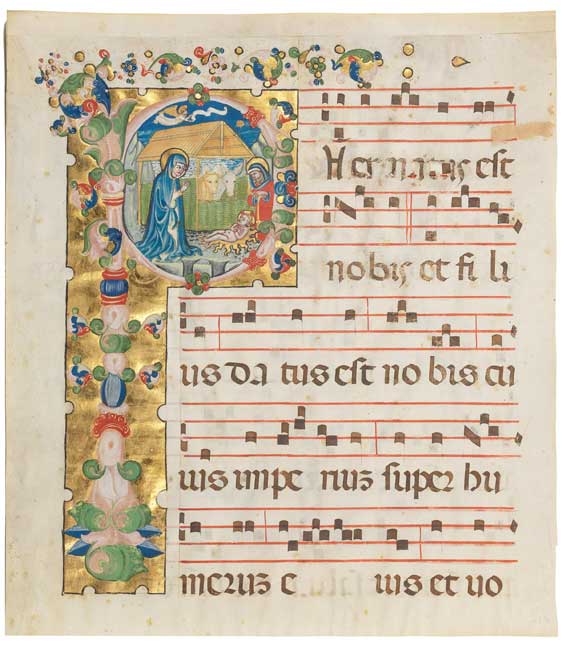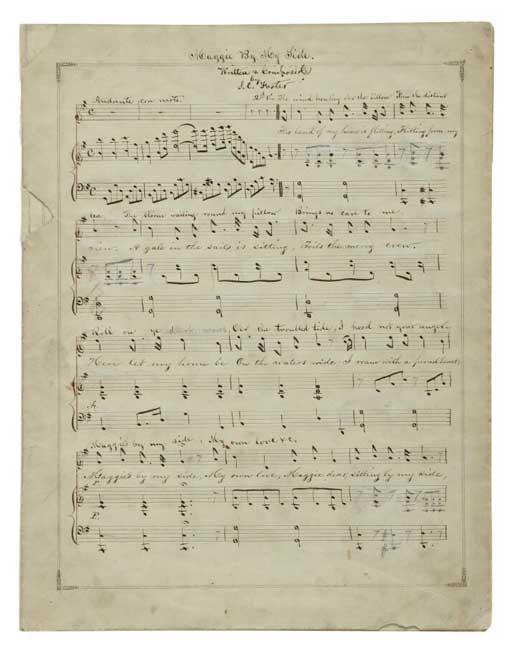Music manuscripts are handwritten sources of music. Generally speaking, they can be written on paper or parchment. If the manuscript contains the composer’s handwriting it is called an autograph. Music manuscripts can contain musical notation as well as texts and images. There exists a wide variety of types from sketches and fragments, to compositional scores and presentation copies of musical works.
The earliest written sources of Western European music can be found in medieval manuscripts of the late 9th century that contain liturgical texts. Above these texts small symbols (neumes) indicated the shape of the melodic lines. Only a few manuscripts survive from that time. New systems were devised over the centuries. Reference: Wikipedia

ILLUMINATED MANUSCRIPT LEAF
The Nativity, from an illuminated Gradual, single leaf, in Latin on vellum, with large illuminated opening initial “P” depicting the Holy family, ox and ass in the stable with angel and star above, the initial on a burnished gold background decorated with acanthus leaves and flourishes in green, blue, pinks and red, similar ornamentation in the upper margin, 10 lines of alternate text and music on four-line red staves, text on verso, one line of text oxidised with some loss, narrow strip (18mm.) of vellum added to head of leaf, 424 x 370mm., [?Bologna, early fifteenth century]; together with another incomplete leaf
Sold for £2,550 inc. premium at Bonham’s in 2022

MENDELSSOHN BARTHOLDY, Felix (1809-1847)
Autograph music manuscript signed and initialled for the duet ‘Sonntagsmorgen’, Op. 77 no 1, Leipzig, 7 May 1840.
3 pages, 300 x 236mm, bifolium, ruled with 16 staves per page, scored for voice and piano, five systems of four staves, autograph title page (‘Duett für 2 Sopran FMB, d.7ten März 1840’), signed, dated and inscribed to Constanze Schleinitz in autograph at the end of the manuscript (‘An Mme. Constanze Schleinitz zu freundlicher Erinnerung Leipzig 7 März 1840 Felix Mendelssohn Bartholdy’), (two adhesive marks at top right and left margins not affecting the music). Provenance: Sotheby’s, 20 May 2005, lot 101.
Sold for GBP 18,750 at Christie’s in 2021

GEORGE GERSHWIN (1898-1937) Autograph musical manuscript “Opening Scene III” from Porgy and Bess.
An autograph musical manuscript in pencil in Gershwin’s hand, circa 1934-35, written on a bifolium of Gershwin’s custom printed landscape format staff paper with his initials “G.G.” to the lower corner, the page headed “Opening Scene III” and comprising about two and half staves, with a small drawing in the margin of a face in profile (likely Porgy). 12 x 15 inches (31 x 38 cm); framed. Vertical fold, extremities toned, a few scuffs and a small stray stain at lower right.
Sold for $20,160 (includes buyer’s premium) at Doyle in 2022
![Music.- Bayly (Richard) [Volume of music], manuscript lyrics and notation](https://antiquemusicals.com/wp-content/uploads/2022/07/music-manuscript-bayly.jpg)
Music.- Bayly (Richard) [Volume of music], manuscript lyrics and notation, 142pp. excluding blanks, signed twice, slightly browned, original roan, gilt, rubbed, some surface wear, worn, trace of worming on lower cover, 106 x 207mm., 1780.
⁂ Songs include: “The new Bath Minuet”; “Ralphs Ramble to London”; “Grano’s march”; “Lord Howe’s Minuet”; “The Black Dance”; “Rakes of London”; “A Plague on these Wenches”; “The Tobacco Box (or Soldiers Pledge of his Love)a Dialogue” etc.
Sold for £750 at Forum Auctions in 2022

Foster, Stephen C.
Autograph music manuscript signed (“S. C. Foster”) of “Maggie By My Side,” from the collection of Harry Houdini
2 pages (305 x 238 mm) on bifolium of engraved 12-stave green paper by John H. Melior, Pittsburgh, music and lyrics in ink with emendations in pencil [Pittsburgh?, ca. 1852]; bifolium separated at fold and repaired, some paper loss at edges (not affecting manuscript music), some staining and soiling. Also included is printed sheet music for the song.
Sold for 32,760 USD at Sotheby’s in 2022